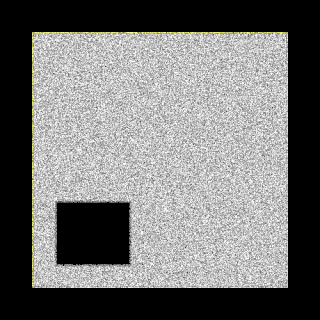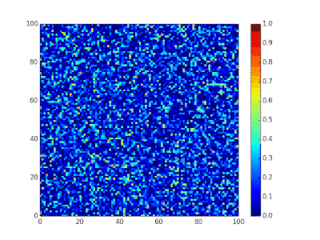Related Research Articles

A cellular automaton is a discrete model of computation studied in automata theory. Cellular automata are also called cellular spaces, tessellation automata, homogeneous structures, cellular structures, tessellation structures, and iterative arrays. Cellular automata have found application in various areas, including physics, theoretical biology and microstructure modeling.
In quantum computing, a quantum algorithm is an algorithm that runs on a realistic model of quantum computation, the most commonly used model being the quantum circuit model of computation. A classical algorithm is a finite sequence of instructions, or a step-by-step procedure for solving a problem, where each step or instruction can be performed on a classical computer. Similarly, a quantum algorithm is a step-by-step procedure, where each of the steps can be performed on a quantum computer. Although all classical algorithms can also be performed on a quantum computer, the term quantum algorithm is generally reserved for algorithms that seem inherently quantum, or use some essential feature of quantum computation such as quantum superposition or quantum entanglement.
A cellular automaton (CA) is Life-like if it meets the following criteria:
A continuous automaton can be described as a cellular automaton extended so the valid states a cell can take are not just discrete, but continuous, for example, the real number range [0,1]. The cells however remain discretely separated from each other. One example is called computational verb cellular network (CVCN), of which the states of cells are in the region of [0,1].

A block cellular automaton or partitioning cellular automaton is a special kind of cellular automaton in which the lattice of cells is divided into non-overlapping blocks and the transition rule is applied to a whole block at a time rather than a single cell. Block cellular automata are useful for simulations of physical quantities, because it is straightforward to choose transition rules that obey physical constraints such as reversibility and conservation laws.
A topological quantum computer is a theoretical quantum computer proposed by Russian-American physicist Alexei Kitaev in 1997. It employs quasiparticles in two-dimensional systems, called anyons, whose world lines pass around one another to form braids in a three-dimensional spacetime. These braids form the logic gates that make up the computer. The advantage of a quantum computer based on quantum braids over using trapped quantum particles is that the former is much more stable. Small, cumulative perturbations can cause quantum states to decohere and introduce errors in the computation, but such small perturbations do not change the braids' topological properties. This is like the effort required to cut a string and reattach the ends to form a different braid, as opposed to a ball bumping into a wall.
A quantum Turing machine (QTM) or universal quantum computer is an abstract machine used to model the effects of a quantum computer. It provides a simple model that captures all of the power of quantum computation—that is, any quantum algorithm can be expressed formally as a particular quantum Turing machine. However, the computationally equivalent quantum circuit is a more common model.
Brosl Hasslacher was a theoretical physicist.
Quantum dot cellular automata are a proposed improvement on conventional computer design (CMOS), which have been devised in analogy to conventional models of cellular automata introduced by John von Neumann.

In cellular automata, the von Neumann neighborhood is classically defined on a two-dimensional square lattice and is composed of a central cell and its four adjacent cells. The neighborhood is named after John von Neumann, who used it to define the von Neumann cellular automaton and the von Neumann universal constructor within it. It is one of the two most commonly used neighborhood types for two-dimensional cellular automata, the other one being the Moore neighborhood.
The majority problem, or density classification task, is the problem of finding one-dimensional cellular automaton rules that accurately perform majority voting.

Rule 184 is a one-dimensional binary cellular automaton rule, notable for solving the majority problem as well as for its ability to simultaneously describe several, seemingly quite different, particle systems:

The Feynman checkerboard, or relativistic chessboard model, was Richard Feynman’s sum-over-paths formulation of the kernel for a free spin-½ particle moving in one spatial dimension. It provides a representation of solutions of the Dirac equation in (1+1)-dimensional spacetime as discrete sums.

Lattice gas automata (LGCA), or lattice gas cellular automata, are a type of cellular automaton used to simulate fluid flows, pioneered by Hardy–Pomeau–de Pazzis and Frisch–Hasslacher–Pomeau. They were the precursor to the lattice Boltzmann methods. From lattice gas automata, it is possible to derive the macroscopic Navier–Stokes equations. Interest in lattice gas automaton methods levelled off in the early 1990s, as the interest in the lattice Boltzmann started to rise. However, an LGCA variant, termed BIO-LGCA, is still widely used to model collective migration in biology.

Vladimir E. Korepin is a professor at the C. N. Yang Institute of Theoretical Physics of the Stony Brook University. Korepin made research contributions in several areas of mathematics and physics.

John Harrison Watrous is the Technical Director of IBM Quantum Education at IBM and was a professor of computer science at the David R. Cheriton School of Computer Science at the University of Waterloo, a member of the Institute for Quantum Computing, an affiliate member of the Perimeter Institute for Theoretical Physics and a Fellow of the Canadian Institute for Advanced Research. He was a faculty member in the Department of Computer Science at the University of Calgary from 2002 to 2006 where he held a Canada Research Chair in quantum computing.

Classic epidemic models of disease transmission are described in Compartmental models in epidemiology. Here we discuss the behavior when such models are simulated on a lattice. Lattice models, which were first explored in the context of cellular automata, act as good first approximations of more complex spatial configurations, although they do not reflect the heterogeneity of space. Lattice-based epidemic models can also be implemented as fixed agent-based models.
Norman H. Margolus is a Canadian-American physicist and computer scientist, known for his work on cellular automata and reversible computing. He is a research affiliate with the Computer Science and Artificial Intelligence Laboratory at the Massachusetts Institute of Technology.

A reversible cellular automaton is a cellular automaton in which every configuration has a unique predecessor. That is, it is a regular grid of cells, each containing a state drawn from a finite set of states, with a rule for updating all cells simultaneously based on the states of their neighbors, such that the previous state of any cell before an update can be determined uniquely from the updated states of all the cells. The time-reversed dynamics of a reversible cellular automaton can always be described by another cellular automaton rule, possibly on a much larger neighborhood.
The following timeline starts with the invention of the modern computer in the late interwar period.
References
- 1 2 Watrous, John (1995), "On one-dimensional quantum cellular automata", Proc. 36th Annual Symposium on Foundations of Computer Science (Milwaukee, WI, 1995), Los Alamitos, CA: IEEE Comput. Soc. Press, pp. 528–537, doi:10.1109/SFCS.1995.492583, ISBN 0-8186-7183-1, MR 1619103, S2CID 7441203 .
- 1 2 3 C. Pérez-Delgado and D. Cheung, "Local Unitary Quantum Cellular Automata", Phys. Rev. A 76, 032320, 2007. See also arXiv:0709.0006 (quant-ph)
- ↑ D.J. Shepherd, T. Franz, R.F. Werner: Universally programmable Quantum Cellular Automaton. Phys. Rev. Lett. 97, 020502 (2006)
- ↑ P. Arrighi, R. Fargetton, Z. Wang, Intrinsically universal one-dimensional quantum cellular automata in two flavours, Fundamenta Informaticae Vol.91, No.2, pp.197-230, (2009). See also (quant-ph)
- ↑ P. Arrighi, J. Grattage, A quantum Game of Life, Proceedings of JAC 2010, Turku, December 2010. TUCS Lecture Notes 13, 31-42, (2010). See also (quant-ph) and (Companion Website)
- 1 2 3 B. Schumacher and R. Werner, "Reversible quantum cellular automata", quant-ph/0405174
- 1 2 3 Pablo Arrighi, Vincent Nesme, Reinhard Werner, One-dimensional quantum cellular automata over finite, unbounded configurations. See also (quant-ph)
- 1 2 Pablo Arrighi, Vincent Nesme, Reinhard Werner, N-dimensional quantum cellular automata. See also (quant-ph)
- ↑ R. Feynman, "Simulating physics with computers", Int. J. Theor. Phys. 21, 1982: pp. 467–488.
- ↑ D. Deutsch, "Quantum theory, the Church-Turing principle and the universal quantum computer" Proceedings of the Royal Society of London A 400 (1985), pp. 97–117.
- ↑ G. Grossing and A. Zeilinger, "Quantum cellular automata", Complex Systems 2 (2), 1988: pp. 197–208 and 611–623.
- ↑ W. van Dam, "Quantum cellular automata", Master Thesis, Computer Science Nijmegen, Summer 1996.
- ↑ C. Dürr and M. Santha, "A decision procedure for unitary linear quantum cellular automata", quant-ph/9604007 .
- ↑ C. Dürr, H. LêTanh, M. Santha, "A decision procedure for well-formed linear quantum cellular automata", Rand. Struct. Algorithms 11, 1997: pp. 381–394. See also cs.DS/9906024.
- ↑ J. Gruska, "Quantum Computing", McGraw-Hill, Cambridge 1999: Section 4.3.
- ↑ Pablo Arrighi, An algebraic study of unitary one dimensional quantum cellular automata, Proceedings of MFCS 2006, LNCS 4162, (2006), pp122-133. See also quant-ph/0512040
- ↑ S. Richter and R.F. Werner, "Ergodicity of quantum cellular automata", J. Stat. Phys. 82, 1996: pp. 963–998. See also cond-mat/9504001
- ↑ P. Arrighi, An overview of quantum cellular automata, arXiv:1904.12956
- ↑ Terry Farrelly, A review of Quantum Cellular Automata arXiv:1904.13318
- ↑ D. Meyer, "From quantum cellular automata to quantum lattice gases", Journal of Statistical Physics 85, 1996: pp. 551–574. See also quant-ph/9604003.
- ↑ D. Meyer, "On the absence of homogeneous scalar unitary cellular automata'", Physics Letters A 223, 1996: pp. 337–340. See also quant-ph/9604011.
- ↑ B. Boghosian and W. Taylor, "Quantum lattice-gas model for the many-particle Schrödinger equation in d dimensions", Physical Review E 57, 1998: pp. 54–66.
- ↑ P. Love and B. Boghosian, "From Dirac to Diffusion: Decoherence in Quantum Lattice Gases", Quantum Information Processing 4, 2005, pp. 335–354.
- ↑ B. Chophard and M. Droz, "Cellular Automata modeling of Physical Systems", Cambridge University Press, 1998.
- ↑ Shakeel, Asif; Love, Peter J. (2013-09-01). "When is a quantum cellular automaton (QCA) a quantum lattice gas automaton (QLGA)?". Journal of Mathematical Physics. 54 (9): 092203. arXiv: 1209.5367 . Bibcode:2013JMP....54i2203S. doi:10.1063/1.4821640. ISSN 0022-2488. S2CID 2351651.
- ↑ P. Tougaw, C. Lent, "Logical devices implemented using quantum cellular automata", J. Appl. Phys. 75, 1994: pp. 1818–1825